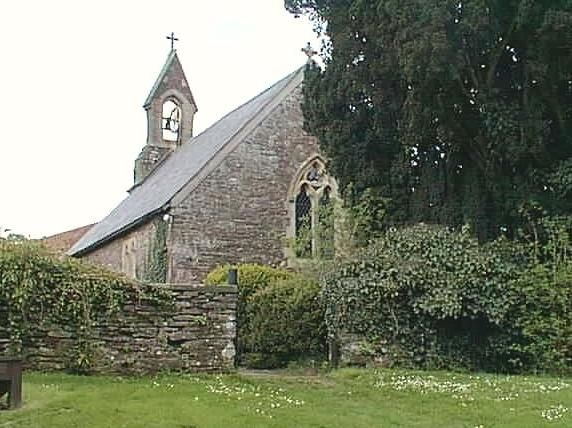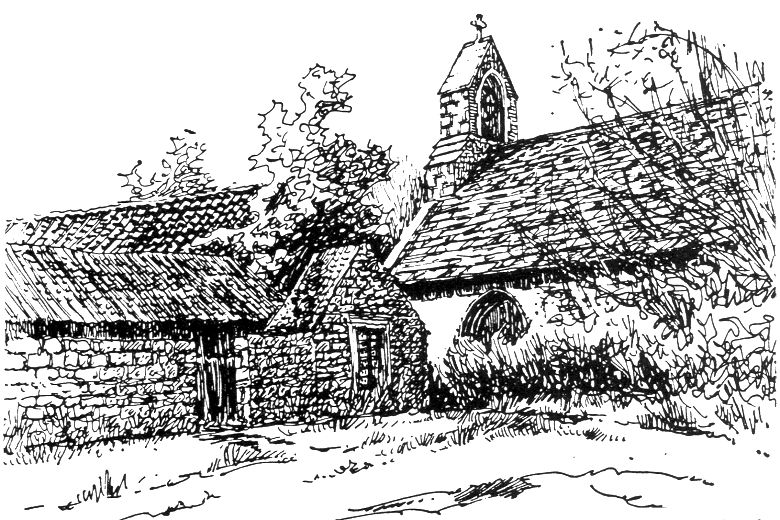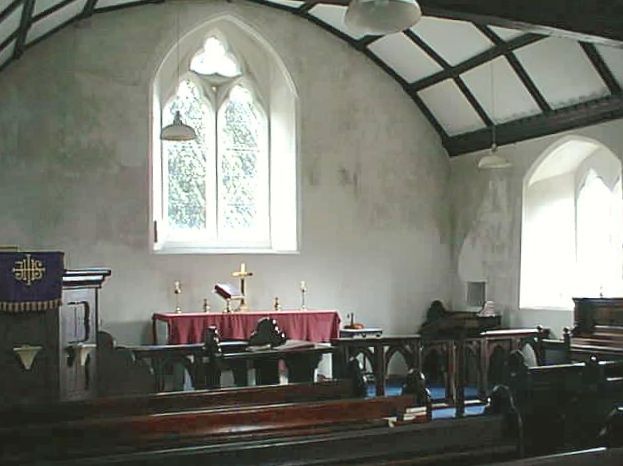Parish Church, Trellech Grange, Monmouthshire
Denomination: Anglican
Dedication: unknown
Built: 13th century
Restored/rebuilt: 1861
|
Photography: John Ball
Date: 8 April 1998
Camera: Agfa ePhoto307 digital compact
|

Note 1: The small rectangular chapel was mostly rebuilt in 1861. [Source: The Old Parish Churches of Gwent, Glamorgan & Gower, by Mike Salter, Folly Publications, Malvern, 1991, ISBN 1-871731-08-9]
Note 2: Built in the Gothic style, long-wall entry type. [Source: Coflein database of the Royal Commission on the Ancient and Historical Monuments of Wales (accessed 27 July 2015)]
Note 3: This is one of Gwent's smallest and least pretentious churches. As the name implies, it was originally a monastic grange, at the heart of Tintern Abbey's sheep-rearing and grazing land. [Source: Ancient Gwent Churches, by John R. Guy and Ewart B. Smith, Starling Press Ltd., Risca, Newport, 1980]

Sketch by Fred Hando (1957) [Source: Hando's Gwent: Volume II, Chris Barber (ed.), Blorenge Books, Abergavenny, 1989]
|
Note 4: The church is a small building which was originally a chapel of ease belonging to Tintern Abbey. The old registers refer to it as a chapel, which explains why the adjoining farm is called the Chapel Farm. The church registers for burials commence in the 1830s, but baptisms and marriages took place much earlier. The census of 1861 shows that a curate lived at Chapel Farm. [Source: The Gwent Village Book, by Gwent Federation of Women's Institutes, Countryside Books, Newbury, and GFWI, Usk, 1994]

Note 5: Let me confess that I had not previously lighted on the little church of Trellech Grange. Very simple, almost pathetic, it seemed to me. Obviously of great age, ot has suffered from restorations, as was the fate of so many of our churches in Victorian days. But I was glad to learn that the turret with its bell and wheel—the only one I know—is now safe under a preservation order. I wish that I could report in similar confidence about the fabric of the church. My two companions agreed with me that the ominous cracks in the walls indicated the need for immediate attention and I am sure that our authorities will do all in their power to repair this beloved little sanctuary. In the north wall is a beautiful modern window inserted in loving memory of the two Grange boys who gave their lives in the Great War, 1914-1918 – Private John Edward Davies of the South Wales Borderers and Lieutenant Ralph Wrigley of the Mon. Royal Engineers. [Source: Hando's Gwent: Volume II, Chris Barber (ed.), Blorenge Books, Abergavenny, 1989]
Note 6: The church is a small one, situated in the midst of farm buildings, and is peculiar in having no separate chancel. It was rebuilt on the old foundations in 1861. There are no monumental inscriptions inside except a brass to the memory of Charles Henry Crompton-Roberts of Drybridge, esq., the owner of this place, who was born in 1832 and died in 1891. In the churchyard is a stone nearly obliterated, which may refer to a branch of the old Parkers of Llanllowel:
Martha, wife of Jacob Parker of this Parish,
died Jan, 28 18. . . Aged 72 years.
. . . Parker died Sept. 18th 1837, Aged 81.
James Parker died Jan 17th, 1838, Aged 45.
The living is a perpetual curacy held with Llanishen, under which parish will be found the incumbents. The chalice was a gift of the duke of Beaufort, and is engraved: D.B. T.G. 1746.
[Source: A History of Monmouthshire Vol II Part II. The Hundred of Trelech, Joseph Bradney, Mitchell Hughes and Clarke, London, 1913]
|


